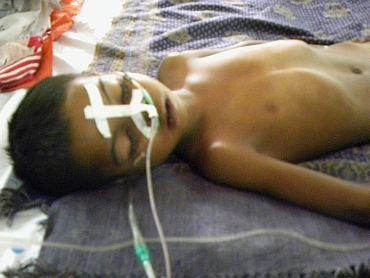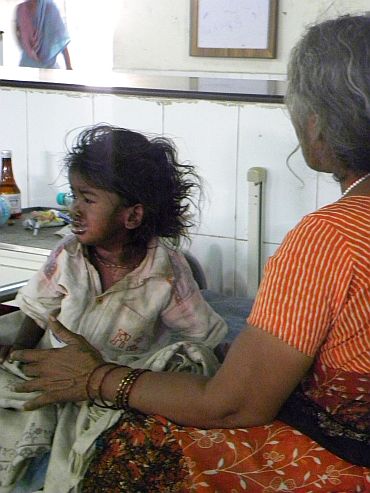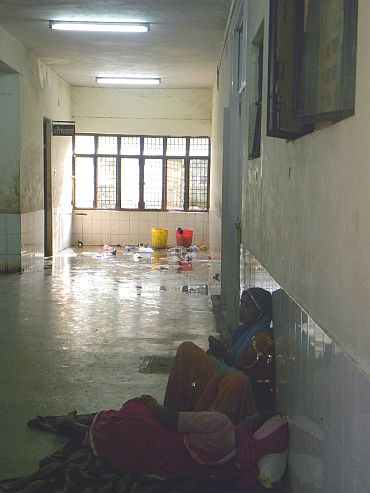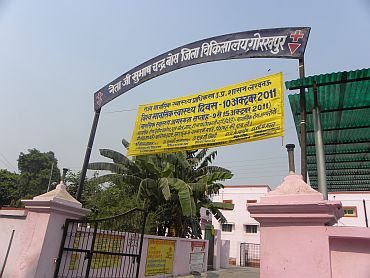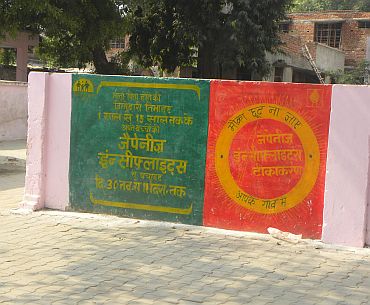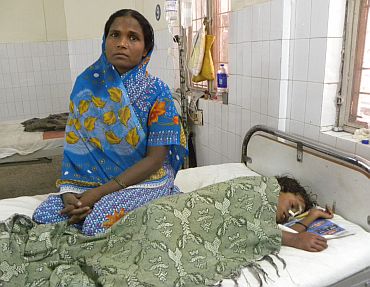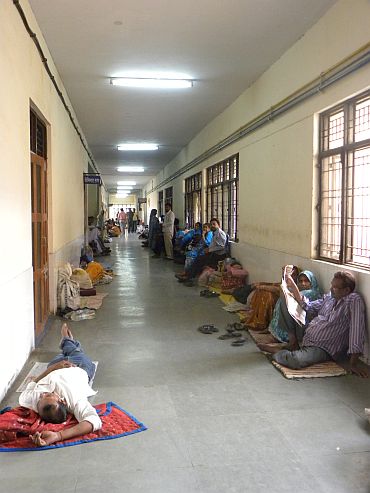 | « Back to article | Print this article |
Only a miracle can end Gorakhpur's encephalitis nightmare
Rediff.com's Nishi Tiwari visits Gorakhpur where the encephalitis 'epidemic' has reached alarming levels.
When the rest of India is soaking in the extended festive season, the general mood in Gorakhpur, Uttar Pradesh, is of despair and helplessness. The annual deadly encephalitis outbreak has hit the city and surrounding villages like clockwork, claiming hundreds of lives, with many of the victims being children.
Since July this year, there have already been 489 deaths, out of which 394 were children. The encephalitis wards in Baba Raghav Das medical college are stuffed beyond capacity -- two to three kids occupy one bed and patients' families camp in the corridors or the hospital's backyard. This, after three 24-bed wards have been assigned for adult patients and four 30-bed wards for children.
Please click NEXT to read further...
'The present day epidemic is a result of three viruses'
Understandably, several doctors have been called in from other places to help. Dr K P Kushwaha, head of the department, paediatrics, says, "We'd called 32 students from medical colleges of Agra, Meerut, Allahabad, Kanpur and Jhansi. 28 of them are still working with us."
The Japanese Encephalitis virus first struck Gorakhpur in 1978 but the present day epidemic is a result of three viruses, doctors at the district hospital say. One of them has been recognised as Enterovirus (entering through intestines) and the other one remains undiagnosed.
Dr R N Mishra, chief medical officer of the Gorakhpur district hospital, breaks it down for us. "Encephalitis is identified in a patient through Acute Encephalitis Syndrome, a cluster of symptoms that occur from brain inflammation. These symptoms include pyrexia (high temperature), irritability, unconsciousness, and convulsions," he says.
Children are the worst sufferers
While Japanese Encephalitis, caused by a mosquito bite, was first identified in India in 1978, Enterovirus, a more recent discovery, is a water-borne disease. This year encephalitis arrived in Gorakhpur in April, and since July, 2,171 kids and 575 adults have been reportedly affected by the disease.
As the figures indicate, children are the worst sufferers since they have weaker immunity than adults. So much so, that the deadly epidemic has left many handicapped. While it stunts their mental growth and learning ability, some kids can't control bladder and bowel movements.
It may have started with the JE virus but Enterovirus has alarmingly emerged as the more destructive of the two in recent years. Dr Sunil Malik, an MD student at the BRD Medical College, reveals, "Only 20 per cent of the cases reported this year were of JE; the non JE cases (encephalitis caused by the Enterovirus) constitute up to 80 per cent of it."
'It's really difficult to make a vaccine'
Dr Kushwaha says, "JE is not an epidemic anymore. There were 30-50 per cent JE cases in the 1990s and it went further down to 22 per cent by 2000. There's been a significant fall of JE cases since the 2005 outbreak too." According to him, the reason behind this is the awareness campaigns that the government carried out in rural areas, informing villagers about the dangers of filth and stagnant water, where mosquitoes breed.
Massive immunisation programmes -- the first one carried out in 2006 and the second one in December last year -- have also resulted in the dramatic fall in JE cases.
So why not do the same for Enterovirus too? Turns out, it's easier said than done. Dr Kushwaha informs us, "Enterovirus is made of countless sub-species of viruses which makes it really difficult to make a vaccine to counter it." Besides, apparently no other region has reported so many non JE cases and a lot of infrastructure and research is required in order to make the vaccine.
Some counter-epidemic efforts have kick-started
A new viral vaccine costs a bomb too, we are told. But National Institute of Virology, Pune, is at work, trying to come up with a vaccine for it.
Efforts on the district level have been kick-started too -- doctors treating encephalitis patients are all praise for the present District Magistrate Sanjay Kumar and Commissioner K Ravindra Naik.
They have been really proactive in this regard, unlike their 'indifferent' and 'sluggish' predecessors. Kumar has ordered to replace all existing hand pumps in affected areas. Most hand pumps used by rural population in and around Gorakhpur at present extract ground water from 20-40 feet, which is often highly contaminated.
To get safe drinking water, it's necessary to go at least 80 feet deep in the ground. Rehabilitation projects for kids handicapped by the epidemic have been initiated too.
'The response of people has been tremendous'
Bhartiya Welfare Social Foundation is a NGO dedicated to spreading awareness about Enteroviral Encephalitis and has taken to performing street plays in various blocks and villages adjoining Gorakhpur.
There first play titled 'Navki Bimari' (new disease) has had a huge impact on its rural audience. Kalindi Nirmal Sharma, chairperson of the NGO, tells us enthusiastically, "Our play is in Bhojpuri, so that they (the villagers) can understand better. We tell them about the importance of hygiene, how mosquitoes and pigs, their eternal co-habitants are carriers of the deadly viruses and how they can avoid contracting the disease by just maintaining basic hygiene."
"The response has been tremendous. We've seen women cry during shows, men have stopped urinating and defecation by the roads. In fact, in a village called Patarka, locals got so petrified when the first encephalitis case was detected in their area that they completely changed the way they live," she adds.
'It will take a holistic social change to completely uproot this menace'
But all this isn't enough. Dr Kushwaha reflects, "Public awareness, proper planning of living conditions in villages, the government meeting its target of providing one hand pump for every 50 rural families -- it will take a holistic social change to completely uproot this menace. In a village, 200-300 people will have mobile phones but only two or three families will have a proper toilet."
He has another grouse, "People here just accept a death in the family as destiny. Look at Andhra Pradesh, there was a huge uproar when the epidemic broke out in the state's coastal areas in 2003. People demanded for cure and mass vaccinations happened immediately, centres were set up to counter it."
That's one of the most widely-accepted reasons for the epidemic's shockingly long stay in the region. Back in 2005, 176 children fell ill and 104 out of them died in UP's Saharanpur district. The team of experts that was sent to find the cause of the illnesses and deaths reported back that the kids fell ill because they ate leaves of a particular acacia species plant. So the disease went unreported.
Government apathy gaining new heights
In another incident, the Muzaffarpur district in Bihar had 156 children with an unknown disease admitted to the medical college. 40-45 per cent of them died and the cause of death wasn't identified. No one had the sense to question the administration or ask for guidance to avoid such casualties in future.
In the face of ignorance and neglect on the people's part, government apathy too is gaining new heights. Reporting encephalitis cases is the worst sin a doctor can commit. Their salaries are cut if they do so. There are no medical colleges in 200 kilometre radius of the district.
It will take nothing less than a miracle to end Gorakhpur's nightmare.
